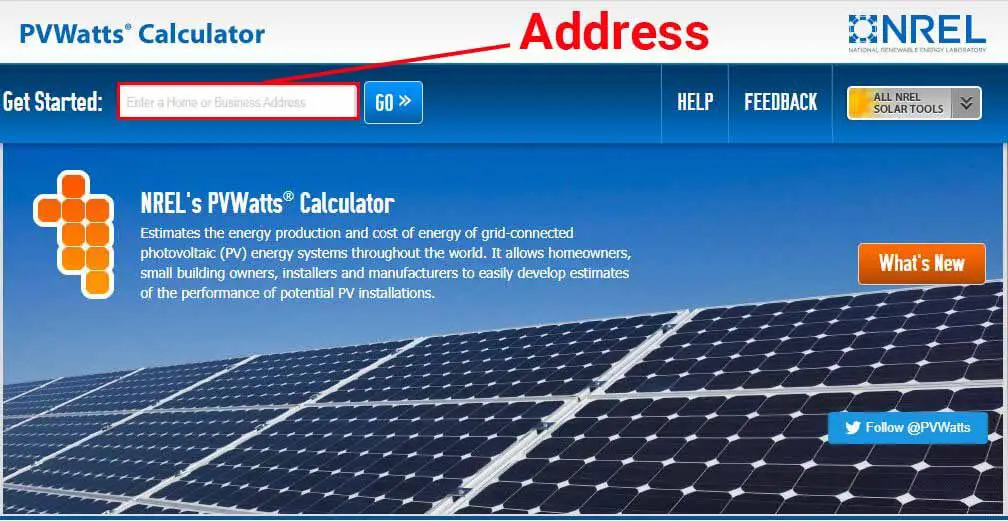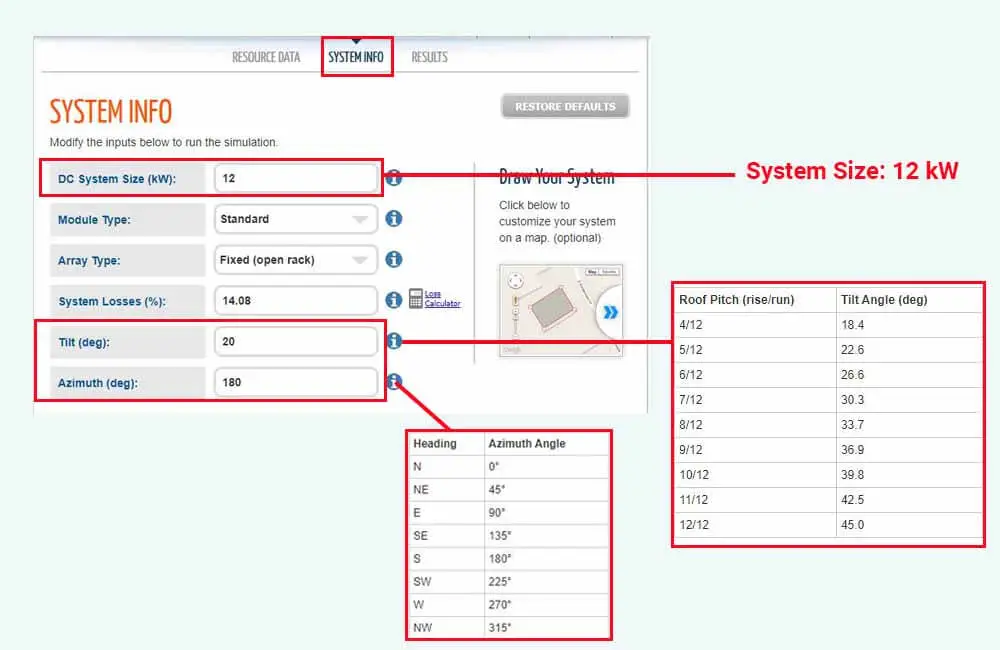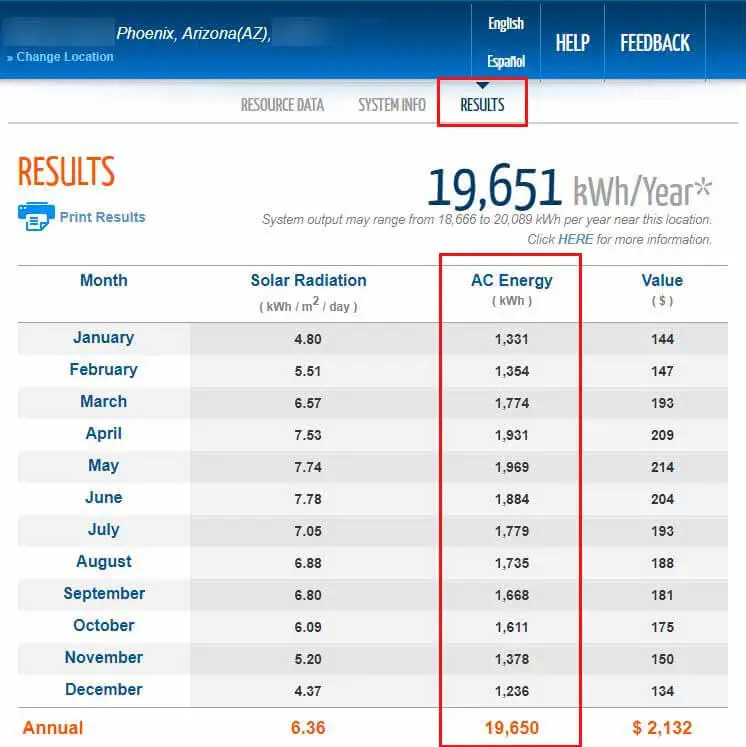A 12kW solar system is a relatively large system and would produce a relatively high amount of energy. However, the exact amount of energy that a 12kW solar system produces would depend on the amount of sunlight that it receives.
The amount of sunlight that a solar panel receives is quantifiable and depends on things weather and seasons, but mainly, it depends on your location.
In this article, I will show you how to determine the average amount of energy that a 12 kW system would be able to generate in your location, and I’ll also answer a couple of frequently asked questions.
How much does a 12kw solar system produce?
The amount of energy that a 12kW solar system produces each day (or month) will mainly depend on the following factors:
- Location.
- Tilt angle and direction.
- Weather and season.
However, assuming the 12kW solar system is facing south, a system of this size would – on average – produce between 45 and 65 kWh of energy per day. This amount of energy equates to about 1400-2000 kWh of monthly energy production.
To give you an idea, the following table estimates the average daily and monthly energy production of a 12kW solar system for different states in the U.S.:
| State | Est. Energy Production per day (kWh/day) | Est. Energy Production per month (kWh/month) |
| Alabama | 55 kWh/day | 1700 kWh/month |
| Arizona | 65 kWh/day | 2000 kWh/month |
| Arkansas | 50 kWh/day | 1600 kWh/month |
| California | 60 kWh/day | 1900 kWh/month |
| Colorado | 60 kWh/day | 1900 kWh/month |
| Connecticut | 50 kWh/day | 1500 kWh/month |
| Delaware | 50 kWh/day | 1600 kWh/month |
| Florida | 60 kWh/day | 1900 kWh/month |
| Georgia | 55 kWh/day | 1700 kWh/month |
| Hawaii | 50 kWh/day | 1600 kWh/month |
| Idaho | 50 kWh/day | 1600 kWh/month |
| Illinois | 50 kWh/day | 1600 kWh/month |
| Indiana | 50 kWh/day | 1500 kWh/month |
| Iowa | 45 kWh/day | 1500 kWh/month |
| Kansas | 50 kWh/day | 1600 kWh/month |
| Kentucky | 50 kWh/day | 1600 kWh/month |
| Louisiana | 55 kWh/day | 1700 kWh/month |
| Maine | 45 kWh/day | 1400 kWh/month |
| Maryland | 50 kWh/day | 1600 kWh/month |
| Massachusetts | 45 kWh/day | 1500 kWh/month |
| Michigan | 40 kWh/day | 1300 kWh/month |
| Minnesota | 45 kWh/day | 1400 kWh/month |
| Mississippi | 55 kWh/day | 1700 kWh/month |
| Missouri | 50 kWh/day | 1600 kWh/month |
| Montana | 45 kWh/day | 1400 kWh/month |
| Nebraska | 55 kWh/day | 1700 kWh/month |
| Nevada | 60 kWh/day | 1900 kWh/month |
| New Hampshire | 45 kWh/day | 1400 kWh/month |
| New Jersey | 50 kWh/ day | 1500 kWh/month |
| New Mexico | 70 kWh/day | 2100 kWh/month |
| New York | 45 kWh/day | 1400 kWh/month |
| North Carolina | 55 kWh/day | 1700 kWh/month |
| North Dakota | 45 kWh/day | 1400 kWh/month |
| Ohio | 45 kWh/day | 1400 kWh/month |
| Oklahoma | 55 kWh/day | 1800 kWh/month |
| Oregon | 50 kWh/day | 1700 kWh/month |
| Pennsylvania | 45 kWh/day | 1400 kWh/month |
| Rhode Island | 50 kWh/day | 1500 kWh/month |
| South Carolina | 55 kWh/day | 1700 kWh/month |
| South Dakota | 50 kWh/day | 1600 kWh/month |
| Tennessee | 50 kWh/day | 1500 kWh/month |
| Texas | 60 kWh/day | 1900 kWh/month |
| Utah | 55 kWh/day | 1800 kWh/month |
| Vermont | 40 kWh/day | 1400 kWh/month |
| Virginia | 50 kWh/day | 1600 kWh/month |
| Washington | 50 kWh/day | 1600 kWh/month |
| West Virginia | 45 kWh/day | 1400 kWh/month |
| Wisconsin | 45 kWh/day | 1400 kWh/month |
| Wyoming | 55 kWh/day | 1800 kWh/month |
Please note that the information provided in the table was estimated using the PVWatts Calculator (provided by NREL). The daily and monthly energy production will generally be higher in the summer and lower in the winter.
Also, the information is based on the assumption that the solar array is facing south (Azimuth = 180 degrees) and is tilted at a 20-degree angle (4-5/12 Roof Pitch), and that the overall system losses add up to 14% (86% system efficiency).
However, the best way to get a personalized and more accurate estimate is to use the PVWatts Calculator yourself:

Once you submit your address, the next step would be to change the default settings in the System Info section of the tool:

In the System Info section, change the following settings:
DC System Size (kW):
In this case, the DC (Direct Current) system size is 12 kW (kiloWatts).
Tilt (deg):
This setting represents the tilt angle (roof pitch) of the section(s) of your roof on which you’ll install the solar panels. Make sure it’s an unshaded roof section that’s preferably facing south. If the south-facing section of your roof is shaded or too small, go for the East, South-East, South-West, or West-facing sections.
If you know the roof pitch of the section, you can click the “i” icon to determine its equivalent in degrees. If you don’t know the roof pitch of the section, you can measure the tilt angle using an app such as Measure for iOS or Bubble Level for Android.
Azimuth:
Azimuth represents the direction that the roof section faces. For example, the azimuth for a south-facing roof section is 180 degrees, the azimuth for a north-facing section is 0 degrees.
To accurately determine the Azimuth, you can use a compass app such as Commander Compass Go for iOS or Azimuth Compass for Android.
The other settings will slightly impact the results, but not nearly as much as tilt and Azimuth settings.
Let’s use the following settings as an example:
- Location: For the location, I’ll submit an address in Phoenix, AZ.
- DC System Size: 12 kW
- Tilt: For the tilt angle, I will assume that the solar panels are installed on a roof section that has a 7/12 roof pitch, which is equivalent to about 30 degrees.
- Azimuth: I’ll also assume that the roof section is facing South-East, which equates to 135 degrees.
I’ve submitted these details to the calculator, and in the Results section, the following table was provided:

Based on the location, the size of the system (12kW), and our description of the roof, the PVWatts Calculator has estimated the annual energy production to be 19650 kWh/year.
You can also see that the monthly energy production differs from month to month. The PV system will generate less energy in the winter as there will generally be less available sunlight.
Watch the following video for more information about the PVWatts Calculator:
How many solar panels does it take to make 12kW?
Residential solar panels differ in size, efficiency, and therefore, differ in power ratings. This means that the exact number of solar panels that you’ll need to create a 12 kW solar system will depend on which solar panels you’re using.
However, residential solar panels will generally be rated at 300-400 Watts, which means you would need around 30 to 40 residential solar panels to make up a 12 kW solar system.
The following table provides some of the most popular residential solar panels, their power ratings, and how many of them would be needed for a 12 kW system:
| Solar Panel Model | Rated Power | Number of solar panels needed for a 12 kW system |
| LG NeON® R Series | 365 – 380 Watts | 32 |
| Canadian Solar SUPERPOWER series | 290 – 305 Watts | 40 |
| FuturaSun FU-M series | 300 – 315 Watts | 38 |
| Panasonic EverVolt Series | 360 – 370 Watts | 34 |
| REC Twin Peak 4 Series | 360 – 375 Watts | 34 |
| LG NeON® 2 72cell Series | 390 Watts | 30 |
| Hyundai HiS-RI Solar Panels | 330 – 360 Watts | 36 |
| Canadian Solar MAXPOWER Series | 325 – 340 Watts | 36 |
| Canadian Solar KuMax series | 380 – 400 Watts | 30 |
| JinkoSolar’s JKM390M-72H | 390 Watts | 30 |
| REC TwinPeak 2S MONO 72 Series | 370 – 400 Watts | 30 |
How much roof space do you need for a 12kW solar system?
On average, a single residential solar panel takes up around 20 ft² (1.72 m²) of space. Assuming the 12 kW solar system consists of 34-36 of these solar panels, such an installation would require around 650-750 ft² (60-70 m²) of roof space.
However, as mentioned above, the number of solar panels that you need for a 12 kW system, and the amount of space that these solar panels would take up, will depend on which solar panels you are using.
The following table provides some of the most popular solar panels, their respective areas, and the amount of space that would be required for a 12 kW system that’s made up of each of these panels:
| Solar Panel Model | Area | Roof space needed for a 12 kW system |
| LG NeON® R Series | 18.6 ft² (1.72 m²) | 596 ft² (55.3 m²) |
| Canadian Solar SUPERPOWER series | 17.6 ft² (1.63 m²) | 704 ft² (65.4 m²) |
| FuturaSun FU-M series | 17.6 ft² (1.63 m²) | 668 ft² (62 m²) |
| Panasonic EverVolt Series | 18.8 ft² (1.74 m²) | 640 ft² (59.4 m²) |
| REC Twin Peak 4 Series | 19.7 ft² (1.83 m²) | 670 ft² (62.2 m²) |
| LG NeON® 2 72cell Series | 22.3 ft² (2 m²) | 670 ft² (62.2 m²) |
| Hyundai HiS-RI Solar Panels | 21.1 ft² (1.96 m²) | 760 ft² (70.6 m²) |
| Canadian Solar MAXPOWER Series | 21.4 ft² (1.98 m²) | 770 ft² (71.5 m²) |
| Canadian Solar KuMax series | 21.4 ft² (1.98 m²) | 642 ft² (59.6 m²) |
| JinkoSolar’s JKM390M-72H | 21.7 ft² (2 m²) | 651 ft² (60.5 m²) |
| REC TwinPeak 2S MONO 72 Series | 21.6 ft² (2 m²) | 648 ft² (60.2 m²) |
To learn more about the different types of residential solar panels and their dimensions, please refer to the following page: How big is a solar panel?


This is the best site I have found so far that explains the whole solar concept. We have been off grid since 1984 with a combination of solar panels, inverter and batteries. We need to upgrade our system so we can use mini-splits and maybe a plugin hybrid some day. We want to get off of evaporate coolers in summer and propane in winter. We will stay off grid as we do not want to hookup to Edison. I will keep studying your information which is very helpful in creating a separate new system. Thanks
Please quote and state the availability of solar panels/ system for running devices capacity 12kw